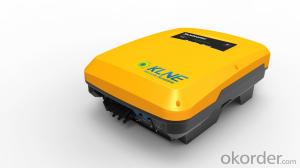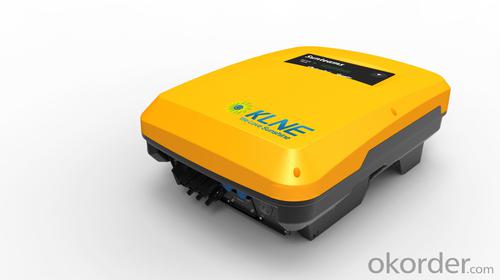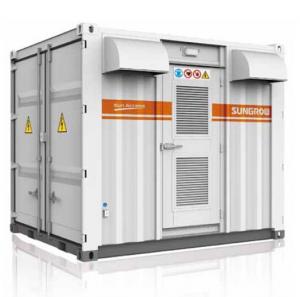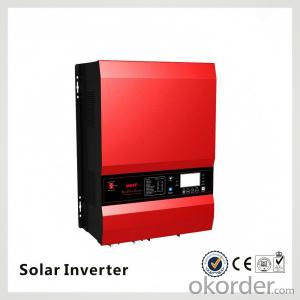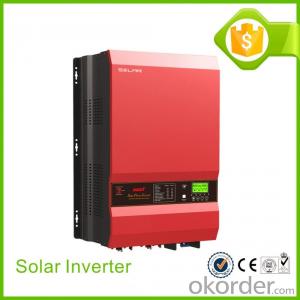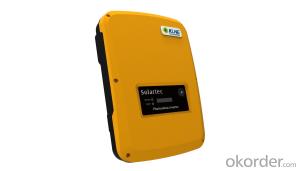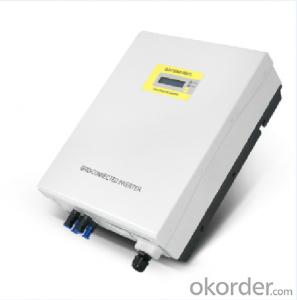Solar Inverter for RV - Solartec 3000-5000 On-Grid Inverter
- Loading Port:
- China Main Port
- Payment Terms:
- TT OR LC
- Min Order Qty:
- -
- Supply Capability:
- -
OKorder Service Pledge
Quality Product, Order Online Tracking, Timely Delivery
OKorder Financial Service
Credit Rating, Credit Services, Credit Purchasing
You Might Also Like
The Solartec 1500~5000 series is applicable to various rooftops and small scale photovoltaic grid-connected power plants. Their nominal output powers are 1.5 kW, 2 kW, 2.5 kW, 3 kW, 3.6 kW, 4 kW, 4.6 kW and 5kW respectively.
This series is transformerless and has a wide range of MPPT input voltage. Its maximum conversion efficiency and MPPT tracking accuracy reach 97.6 % and 99.5 % respectively. The maximum DC voltage reaches 550 V. Its multilingual LCD display facilitates easy operation. It has integrated DC switch and waterproof direct plug-in terminals. It has overvoltage, islanding, short-circuit, overloading and overheating protection functions. Its IP65 protection degree will ensure that it runs well in various tough environments.
Efficient
■ Efficiency of up to 97.6 %
■ Transformerless
■ Efficiency of up to 97.6 %
■ Transformerless
Safe
■ Integrated DC switch
■ Comprehensive protection functions
Flexible
■ LCD backlight
■ For indoor and outdoor installation
Simple
■ ‘Plug and play’connection for easy installation
■ Friendly interface, easy to install and maintain
- Q: Can a solar inverter be used with a solar-powered educational system?
- Yes, a solar inverter can be used with a solar-powered educational system. A solar inverter is an essential component that converts the direct current (DC) produced by solar panels into alternating current (AC) that can be used to power electrical devices, including educational systems. By using a solar inverter, the solar energy generated by the system can be efficiently utilized for educational purposes.
- Q: What is the role of power factor correction in a solar inverter?
- The role of power factor correction in a solar inverter is to improve the efficiency and stability of the system by minimizing the reactive power and optimizing the power factor. This ensures that the inverter operates at its highest efficiency and reduces any voltage drops or disturbances in the grid. Additionally, power factor correction helps to comply with grid regulations and standards, preventing penalties and ensuring smooth integration of solar power into the electrical grid.
- Q: Can a solar inverter be used with different brands of solar panels?
- Yes, a solar inverter can generally be used with different brands of solar panels as long as the panels have compatible voltage and power ratings. However, it is recommended to consult the manufacturer's specifications and guidelines to ensure compatibility and optimal performance.
- Q: What is the power factor correction capability of a solar inverter?
- The power factor correction capability of a solar inverter refers to its ability to correct any power factor issues in the electrical system it is connected to. A solar inverter typically aims to achieve a power factor as close to 1 as possible, which indicates a balanced and efficient use of electrical power. By actively monitoring and adjusting the power factor, a solar inverter ensures that the energy generated from the solar panels is effectively utilized and does not cause any unnecessary strain on the electrical grid.
- Q: PV grid-connected inverter and independent inverter in the control of what is the difference
- The independent inverter in the output voltage phase amplitude of the frequency control is initially set good. Independent inverter, you should refer to off-grid inverter, do not need to consider the grid situation.
- Q: Can a solar inverter be installed indoors or outdoors?
- A solar inverter can be installed both indoors and outdoors. However, it is generally recommended to install it indoors to protect it from harsh weather conditions and extend its lifespan.
- Q: What is the role of a solar inverter in a solar-powered telecommunications system?
- The role of a solar inverter in a solar-powered telecommunications system is to convert the direct current (DC) produced by the solar panels into alternating current (AC) that can be used to power the telecommunications equipment. It also ensures that the AC power is stable and at the necessary voltage and frequency for the proper functioning of the system.
- Q: What are the common issues and troubleshooting steps for a solar inverter?
- Common issues with solar inverters can include issues with the inverter not turning on, no power output, low power output, intermittent power output, or error messages displayed on the inverter. Here are some troubleshooting steps to address these issues: 1. Check the power supply: Make sure that the inverter is properly connected to the power source and that there is no issue with the electrical supply. Check the circuit breaker or fuse box to ensure it has not tripped. 2. Inspect the wiring: Examine the wiring connections to ensure they are secure and not damaged. Loose or disconnected wires can cause power issues. If any damage is found, consider contacting a professional electrician to repair or replace them. 3. Clean solar panels: Dust, debris, or shading on solar panels can reduce the power output. Clean the panels using a soft cloth or a hose. If there is shading from nearby trees or structures, consider trimming or removing them if possible. 4. Check for error messages: If the inverter displays an error message, refer to the user manual or manufacturer's website for the meaning of the error code and recommended troubleshooting steps. If necessary, contact the manufacturer's customer support for further assistance. 5. Monitor the weather conditions: Solar inverters may have reduced power output during cloudy or overcast days. However, if the power output is consistently low even in optimal weather conditions, there may be an issue with the inverter itself. 6. Reset the inverter: Some inverters have a reset button or option. Try resetting the inverter to its factory settings, but keep in mind that doing so may erase any customized settings or configurations. 7. Firmware updates: Check if there are any available firmware updates for your specific inverter model. Updating the firmware can sometimes resolve issues and improve performance. 8. Consult a professional: If the troubleshooting steps above do not resolve the issue, it is recommended to contact a professional solar installer or electrician. They have the expertise and equipment to diagnose and repair more complex issues with solar inverters. Remember, safety should always be a priority when troubleshooting electrical equipment. If you are unsure or uncomfortable with any troubleshooting steps, it is best to seek professional assistance to avoid any potential hazards.
- Q: What is the difference between a grid-connected inverter and an off-grid inverter? What are the advantages of a hybrid inverter?
- Grid-connected inverter will be directly sent to the power grid, so to track the frequency of the grid, phase, the equivalent of a current source. Of course, there are some inverters that have a low-pressure through the ability to do PQ adjustment.
- Q: Can a solar inverter be used in extreme weather conditions?
- Yes, solar inverters are designed to withstand a wide range of weather conditions, including extreme heat, cold, humidity, and even harsh environmental factors. They are built to be durable and reliable, ensuring their functionality and performance in various climates and weather conditions.
Send your message to us
Solar Inverter for RV - Solartec 3000-5000 On-Grid Inverter
- Loading Port:
- China Main Port
- Payment Terms:
- TT OR LC
- Min Order Qty:
- -
- Supply Capability:
- -
OKorder Service Pledge
Quality Product, Order Online Tracking, Timely Delivery
OKorder Financial Service
Credit Rating, Credit Services, Credit Purchasing
Similar products
Hot products
Hot Searches
Related keywords
